There are numerous different types of bread, but they all share the same characteristic of being an excellent energy source. Indeed, bread is a staple food in many cultures, especially in Western. However, it does not mean that Asia or other continents do not consume the bread.
According to history records, the initial bread appeared in approximately 8,000 BC in the Middle East, particularly in Egypt. It can be seen as a sign of the first human societies in the past.
The story behind bread, be it from the East or the West, is so interesting to explore. That’s why I am here, to show you 37 famous bread made from various dough kinds globally. Let’s dive into this post to learn more!
Wait no longer! Let’s dig into the world of bread with me!
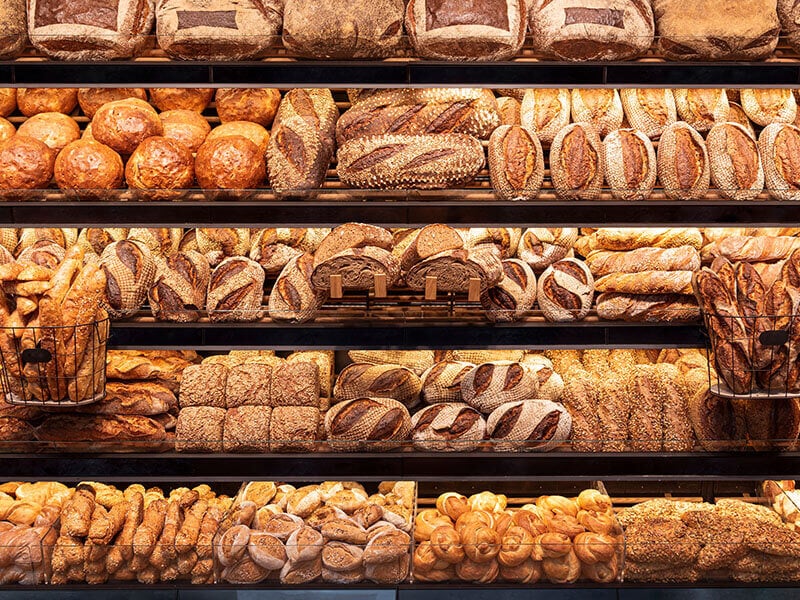
Flatbread – The Easiest Recognisable Type Of Bread
Flatbread is simply a kind of bread with a flat appearance and in different sizes. Most flatbreads are made from unleavened dough. There are also various ways to prepare flatbreads like baking, grilling, or frying. Some can be enjoyed fresh.
In this part, I will cover 9 well-loved flatbreads in many places worldwide. They all have distinctive characteristics. And the following table will show you some main information about them.
1. Pita
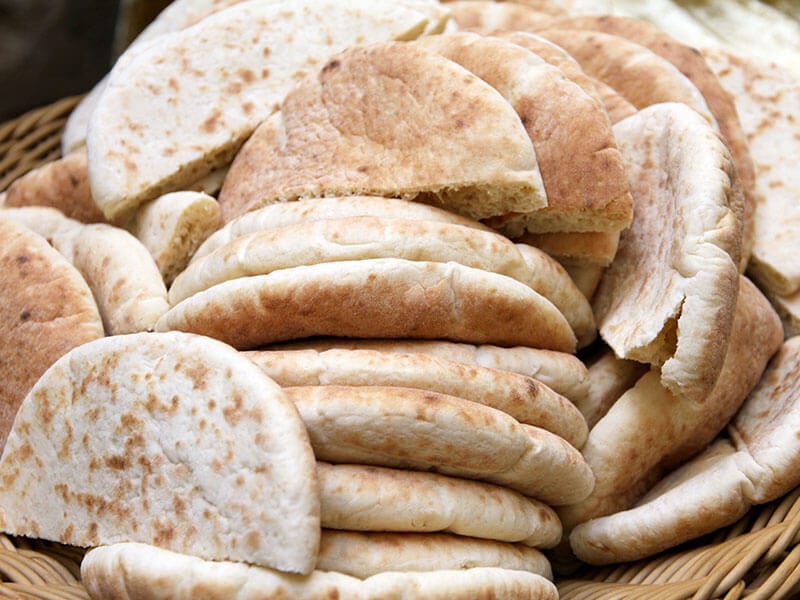
The exact root of Pita is still in doubt, but many people believe that they were from the Middle East. Though many flatbreads are unleavened, pita is the exception. They are yeast-leavened bread made from wheat flour, water, and salt.
Nowadays, Pita is a staple food in the Middle East, Mediterranean, and nearby regions. So why are they called Pita? This name might derive from the term “πίτα”, which means cake or bread in Modern Greek.
There are many variations of pita with several styles, but most pita bread is baked from 450 to 475 degrees F to be hot enough to heat the water in pita dough and create steam. That is one reason why pita usually has an open form like a pocket.
The versatility of this bread in culinary is wide as well. They are an indispensable part of Middle Eastern meals as they can go well with sauces, dips, or as a sandwich to wrap kebabs or falafel.
Check this demonstration to learn to make pita bread with ease.
2. Chapati
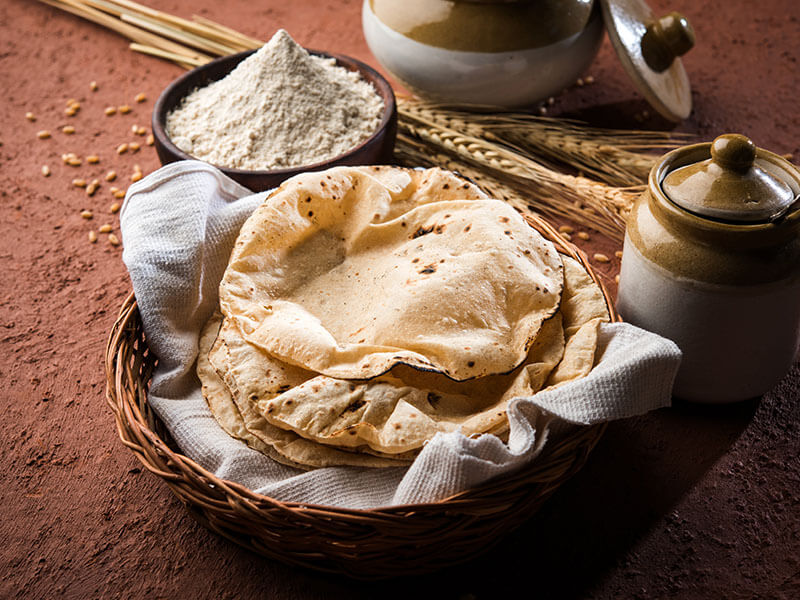
Let’s move to India to find out about their special bread – Chapati. These are the unleavened flatbread that you can easily find in everyday meals in Sri Lanka, Nepal, Bangladesh, East Africa, Pakistan, the Caribbean, Arabian Peninsula, etc.
Of course, Chapati is one of the most popular side dishes in India, and they can accompany various types of recipes.
In Hindi, the term “chapat” means “slap”, referring to the way people use their wet hands to slap the dough. Chapati’s components are very simple, including whole-wheat flour (atta) and water. The locals also add salt or oil into the dough mixture, then cook them on a flat skillet (tava) and open-flame.
To prepare this bread, the dough requires a minimum of 10 minutes to 1 hour to proof so it can be softer. Chapati’s sizes and thicknesses are different in various regions, but they are not bigger than 7-inch in diameter.
3. Roti Canai
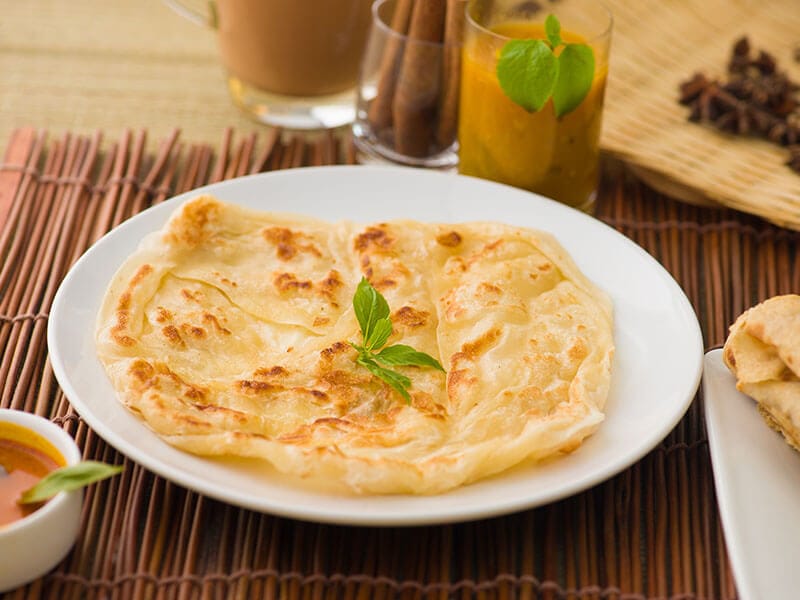
Roti Canai is a well-known Malaysian street food that the natives usually enjoy on breakfast (or as a snack). Indeed, Malaysian cuisine is strongly affected by South Indian cuisine, and Roti Canai is an obvious example.
Besides Malaysia, this is also a popular bread in neighboring countries, like Singapore, Indonesia, Thailand, and Brunei. And the first appearance of Roti Canai can be traced back to the 19th century when Indian Muslims brought it to Malaysia.
Generally, Roti Canai consists of flour, fat (normally ghee), and water to make the dough. Then people will knead, flat, oil, and fold the bread prior to proofing them so they can create more layers. After that, they will flatten the dough ball again.
Some Roti Canai versions come with fillings like eggs and onions. But in Malaysia, Roti Canai is mostly served plain to pair with curry.
Bring some Malaysian street food vibes to your kitchen with the homemade Roti Canai!
4. Tortilla
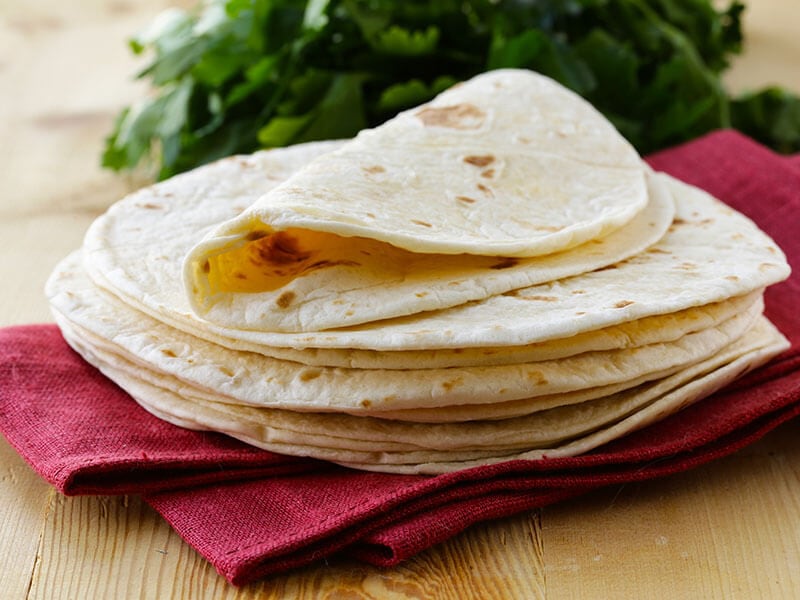
Tortilla is my favorite round-shaped flatbread. This thin bread is a Latin American specialty that is usually associated with Mexican cuisine. It is made from finely ground maize dough (aka masa harina). Moreover, the natives use it to scoop many flavorful Mexican foods like stews or sauces.
Some tortillas include wheat flour, particularly in the northern region of Mexico. In this version, teople add fats (like lard or oil), salt, baking powder, etc., to their recipes. And they use a flat Mexican-style griddle for cooking it.
Plus, there are various ways to enjoy tortillas. They can work in the manner of sandwiches (like making tacos) or as a wrapper for enchiladas treats. If you want to enjoy them for a Mexican-based breakfast, fry some eggs and tortillas and serve them along with some slices of avocado.
5. Naan
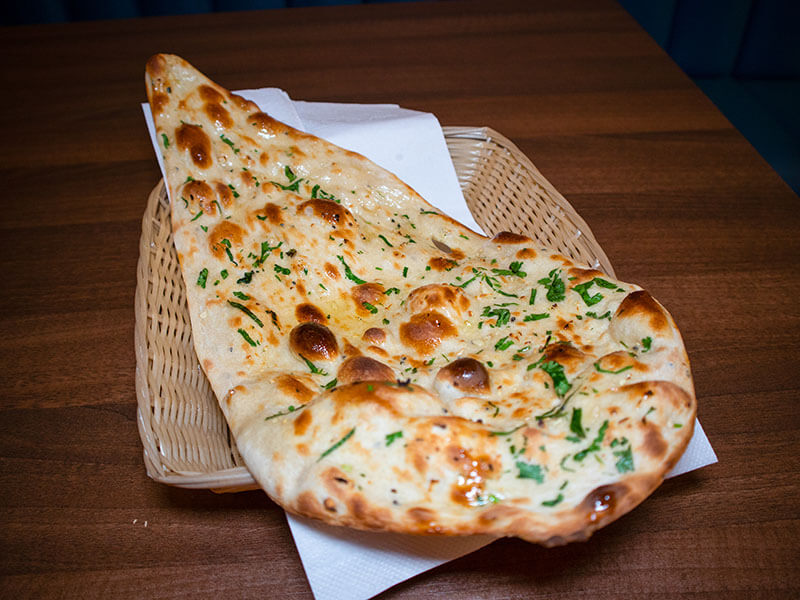
Like Pita, Naan is a leavened flatbread, but they are usually softer than Pita. The English form “naan” comes from “nān” in Persian, meaning bread. This kind of bread is super popular in India, Western and Central Asia, and the Caribbean.
Of course, Naan comes with distinct styles, ingredients, or cooking techniques in different regions. For example, Naan can be leavened or unleavened, and locals can use milk in place of water.
A normal naan will need some minutes to knead, then leave the dough to rise in hours. After they rise, people divide the dough into smaller balls to flatten before baking them. In India, the traditional way to cook it is in a clay tandoor oven. But some countries will use a flat pan tava for cooking it.
How do Indians bake Naan bread? This documentary will show you.
6. Matzah
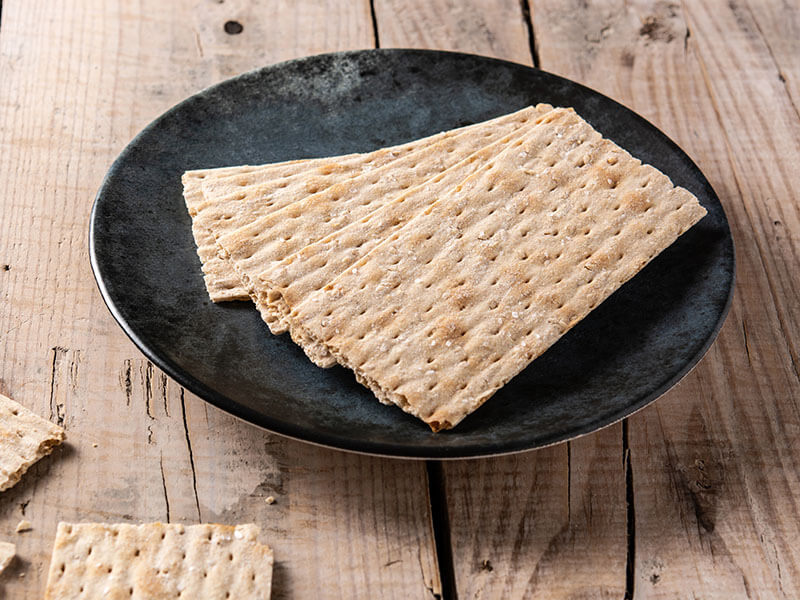
Matzah (or matzo, matza) is an important Jewish flatbread made from unleavened dough and originated from ancient Israel. If you have ever joined a big Jewish holiday called Passover in the spring, you have definitely spotted many Matzah bread there.
Matzah bread might look like crackers, and they are baked goods. They can either be soft or crispy. However, the crispy ones are preferred for commercial purposes as soft Matzah doesn’t last long. The ingredients of Matzah are also varied based on its variation.
A simple version mainly includes flour, water, and, sometimes, eggs. However, Jewish rules dictate that the flour must be made from 1 of the following 5 grains: spelt, wheat, barley, oat, or rye.
Therefore, Matzah bread made with onions, poppy seeds, rice, buckwheat, or any untraditional ingredient is not ideal for the Passover holiday.
7. Sangak
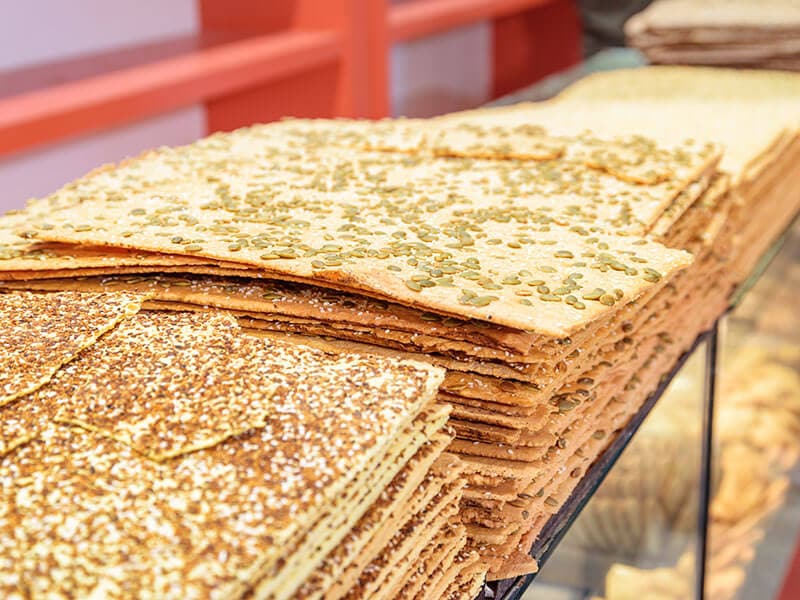
Let’s explore a tasty food of Iran named Sangak. In fact, this is a leavened flatbread, including wheat flour and sourdough. From a first look, it might be hard to recognize Sangak as a type of bread since they are too flat.
The word “sangak” is “little stone” in Persian as they are baked on various river stones in an oven. They come in 2 main types: with or without toppings.
With topping-included Sangak, people add sesame seeds or poppy seeds to enhance their flavors. But generally, these bread have a mild sour taste with a flat and spongy texture that you can easily find at Iran street hawkers.
Sangak is a unique beauty in Iranian cuisine, but how are they made? Check here to see the answer.
8. Focaccia
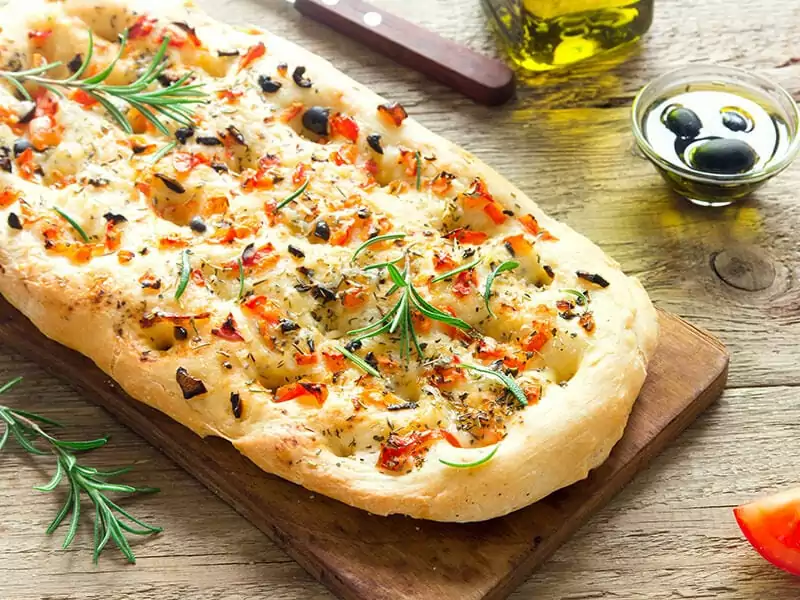
Another leavened flatbread with a certain reputation in the bread world is Focaccia. This is an Italian-originated bread variety served like a pizza. That’s why some places call them “pizza bianca”, which means white pizza in Italian.
But they are not a type of pizza as this bread needs time to rise after being flattened. In contrast, pizza needs to be baked right after the flattening stage.
A bite of Focaccia offers you a bit of crispiness and mildly salty crush along with a soft-yet-chewy texture. But overall, if you seek a simple Italian side dish or sandwich bread, Focaccia is a fantastic candidate.
The variations of Focaccia are numerous. Some of them can be simply made with oil, high-gluten flour, salt, yeast, and water. Some other versions include sugar, honey, raisin, sauce, or ham on the surface.
Do not know what to cook for this weekend? Try Focaccia bread!
9. Paratha
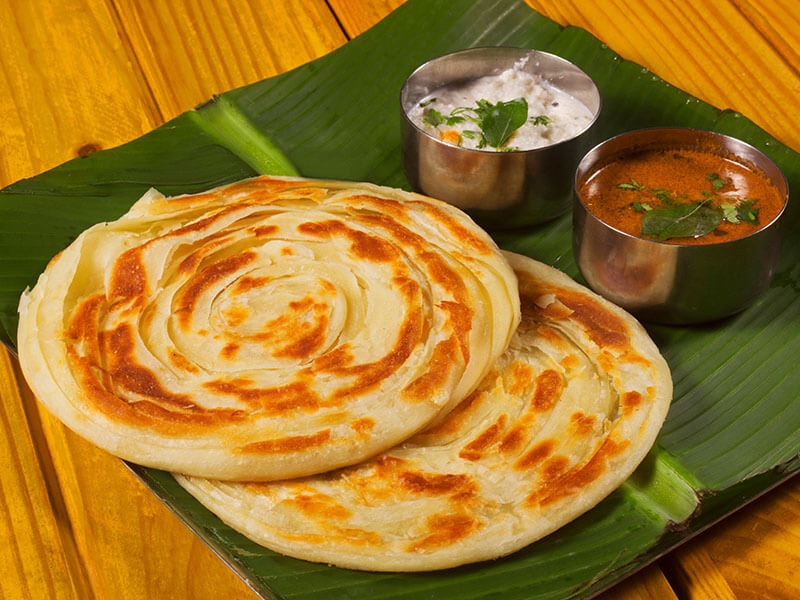
The last (but not least) unleavened flatbread that I want to discuss today is Paratha. Native to Indian subcontinents, like India, Pakistan, Bangladesh, Paratha bread has recently increased its popularity in other Asian countries like Singapore, Malaysia, and Myanmar.
The term “paratha” has a root from “parat” and “atta”, indicating layers of cooked dough. The main ingredients to make this type of flatbread are ghee (or butter, oil), wholemeal wheat flour (atta), and white flour made from wheat – maida.
Typically, locals use a tava pan for cooking a whole dough; then, they move it into a shallow frying pan to finish the cooking part. Compared to Chapati, this flatbread is thicker since they are layered with ghee or oil coating and includes many foldings.
Paratha bread is best suited to enjoy in the morning. They can be a fulfilling breakfast if you pair it with a fried egg, ground mutton, lamb meat, etc. Sometimes, people also stuff other veggies inside this bread, like onions, chili, or potatoes.
Yeast-Leavened Bread Types And Their Stories
Leavening bread by yeast can be seen as the most popular way to make bread. Here are 8 exceptional types of yeast bread from around the world.
10. Baguette
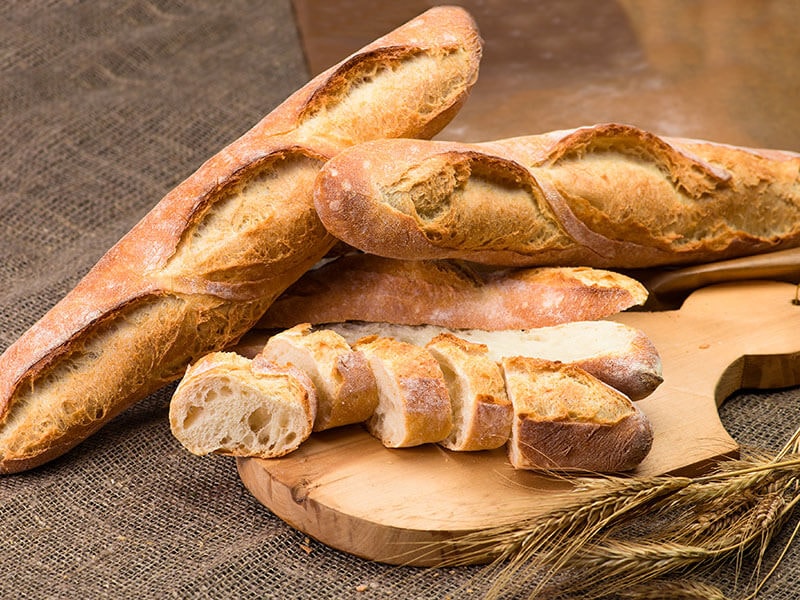
There are several reasons to make this French bread so popular in the bread (and sandwich) world. They are a basic type of bread that can pair excellently with both sweet and savory ingredients, like cheese, pate, butter, jam, or chocolate.
If you wonder whether bread is suitable for a vegan diet, worry no more since baguette is perfectly vegan-friendly. Simply pair this delicious bread with plant-based food and you’re golden.
The exact origin of this bread type is still unclear. Some people think this was an invention of Napoléon Bonaparte to help his soldiers carry food easier. Some claim baguettes were a product of French metro workers.
Overall, today’s baguette has a long, thin shape with around 26-inch in length and 2-inch in diameter. They also have an amazingly crispy crust. But not all long loaves of bread are classified as baguettes in French.
The ingredients to make a baguette are simple, but it requires a lot of foldings and rollings to shape them into a long, thin roll before baking. There are other similar versions of baguette like bánh mì – favorite street food in Vietnam made with a high proportion of rice flour.
This lively documentary will offer you a full picture of making baguettes in France.
11. Challah
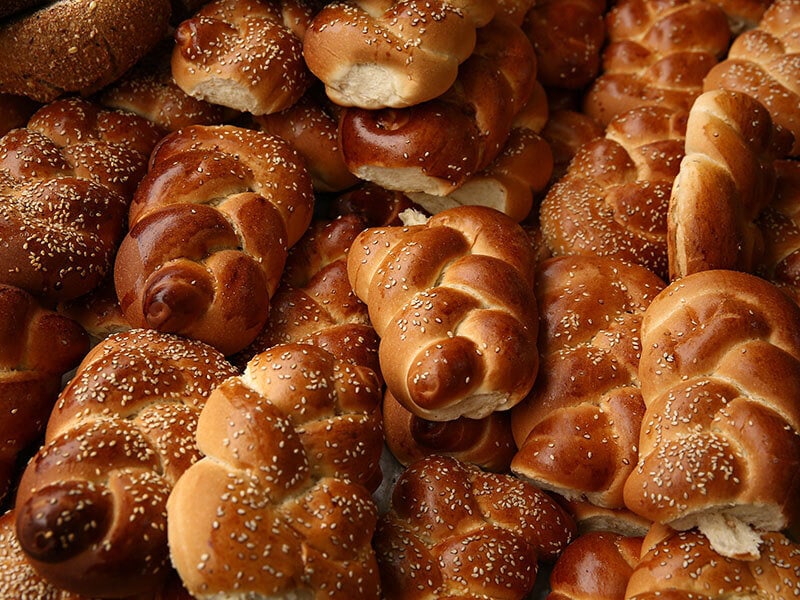
Challah in Biblical Hebrew language refers to a type of cake or loaf. It is an important food for the Israeli people. The origin of Challah is from Ashkenazi Jews. The bread plays a crucial role in many Jewish holidays like Shabbat (the Jewish day of rest).
The traditional ingredients of Challah are white flour, sugar, yeast, eggs, oil, salt, and water. Challah has a long braided-loaf shape and golden skin after baking. It also tastes slightly sweet with a very soft interior.
Nowadays, some recipes use whole wheat, spelt flour, oat, and sweetened by molasses or honey. There are other Challah types, such as Shlissel Challah (key-shaped appearance) and Rosh Hashanah (rolled to have a circular shape).
Here is a short video capturing all information about Challah and how to make it.
12. Rye Bread
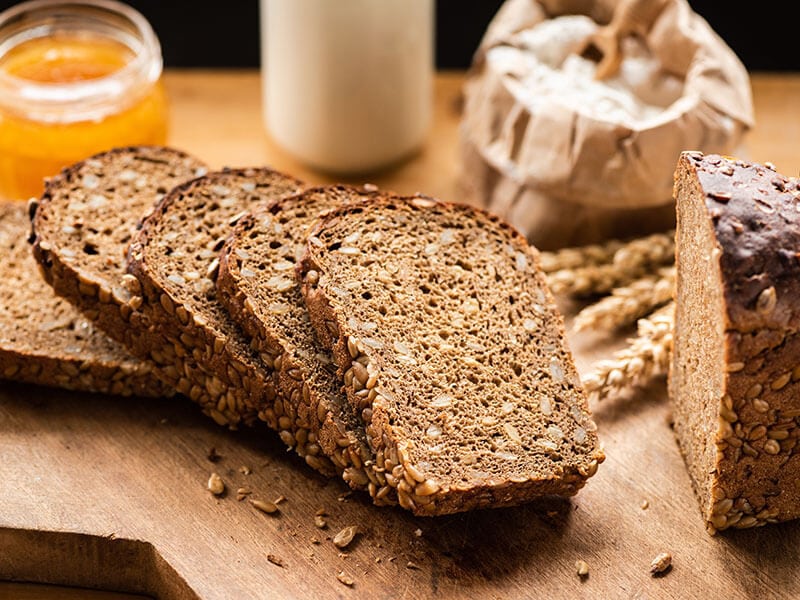
Rye bread can be divided into several smaller bread types, such as quick bread or multigrain bread. But here, I will mainly focus on straight rye bread (or all-rye bread).
Its main ingredient is rye flour. 100% made-with-rye bread tends to be dense, heavy, and dark in color. But if you want to make them lighter texture and color, mix rye flour with other flour, like wheat flour.
These straight rye bread might not rise as high as wheat-flour bread, but their shelf life is much longer than wheat bread, which can last for months. It would be best to cut your rye bread into thin slices for the best enjoyment due to its high density.
With this detailed instruction, let’s prepare a 100% rye bread loaf today!
13. Potato Bread
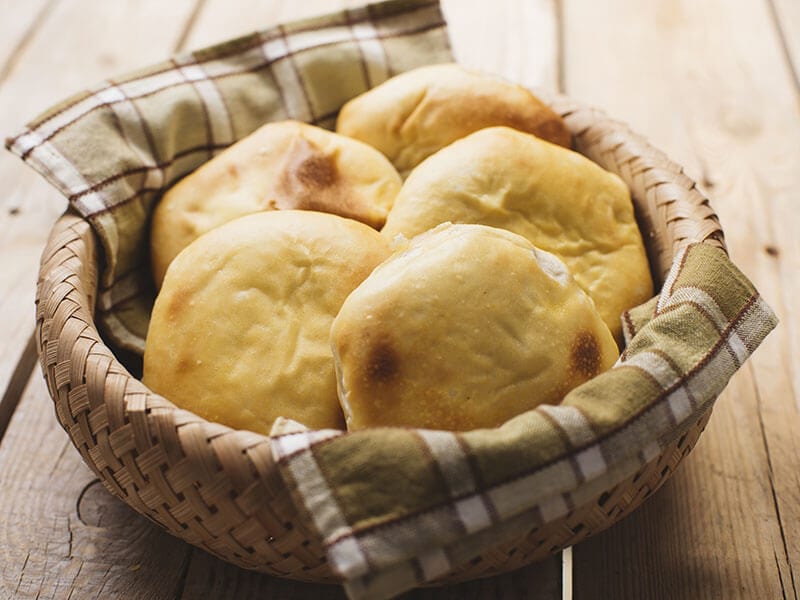
To make a simple upgrade for your regular white bread, potato bread might be the one. Tasty, soft, quite thick in texture with mellow potato flavor, they are a great option to make your favorite sandwich ideas much better.
So instead of using normal wheat flour, you need to use potato flour (or potatoes) to make this bread. It can either be leavened or unleavened bread and come in disparate shapes. You can find a lot of varieties of them in many countries, such as the USA, Germany, Ireland, or Chile.
Indeed, there are not too many limitations in creating the finest potato bread. You can even use mashed potatoes or potato flakes to prepare it.
14. Whole Wheat Bread
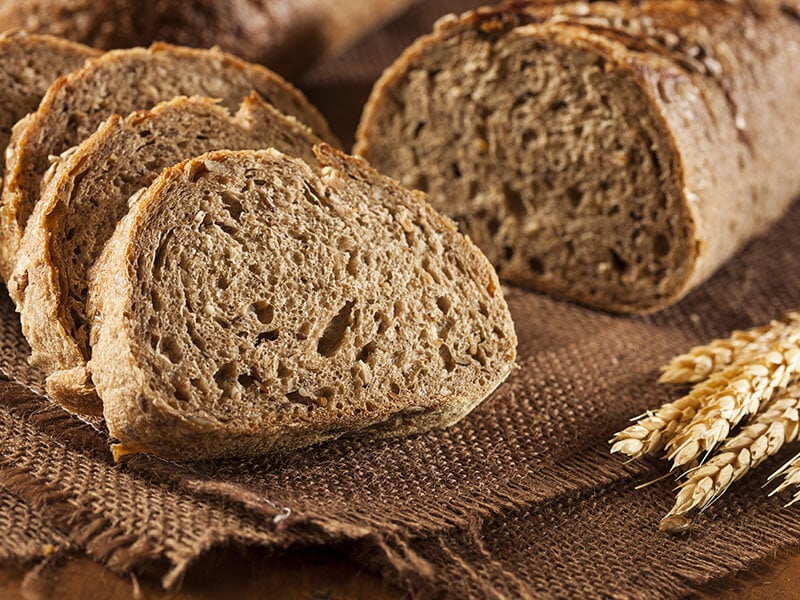
Thanks to its nutrients and fibers, whole wheat bread can be a healthier alternative to white bread. Basically, it consists of partly or entirely ground whole wheat grain (or almost-whole wheat one).
People also use them as a nutritious and delicious type of sandwich bread in place of white bread for a healthier version. Besides, whole wheat bread’s texture can vary widely, from extra coarse to extra fine, according to the grinding levels.
These loaves of bread generally have a darker color than regular white bread, depending on the whole-wheat type a baker chooses to make them. Moreover, you can find some versions with a grain coating for decoration purposes.
Some places in the USA refer to this bread type as “wheat bread”. Ironically, many commercial American bakers use the term “whole bread” to promote products made from wheat flour but containing few whole-wheat grains.
15. English Muffin
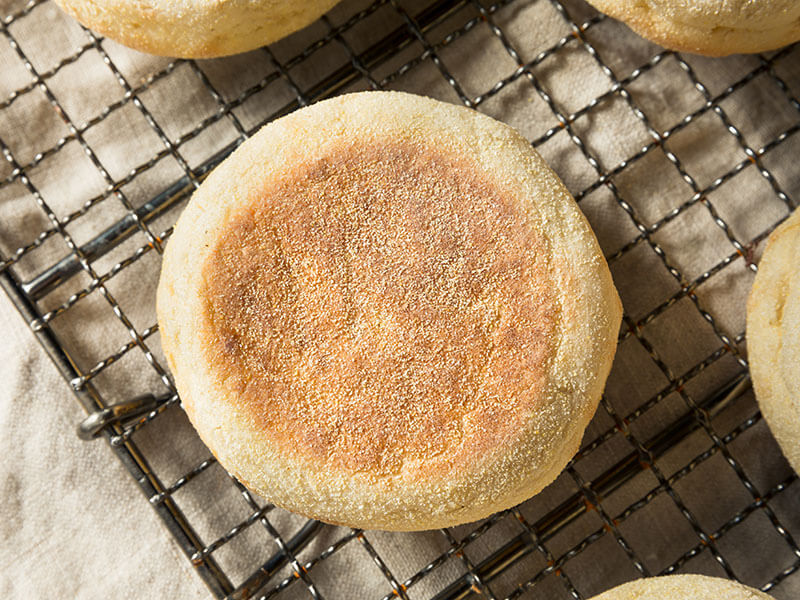
Speaking of yeast bread, the English muffin is another good example. They are small, flat, and round bread that can be a great choice for breakfast, especially in North America, New Zealand, and Australia.
Normally, they will cut them horizontally, then serve with jam, eggs, bacon, etc., to enjoy in the morning since they have a bland flavor. But these English muffins also have many savory versions filled with multigrain, raisin, apple cinnamon, whole wheat, etc.
For more information, muffin means “little cakes” in the Low German language. The name was introduced to the United States in 1859 through newspapers. But do not be confused between English and American muffins, which I will explain in more detail later.
Basic English muffins are easy to make! But how simple is it? Click here to find out!
16. Brioche
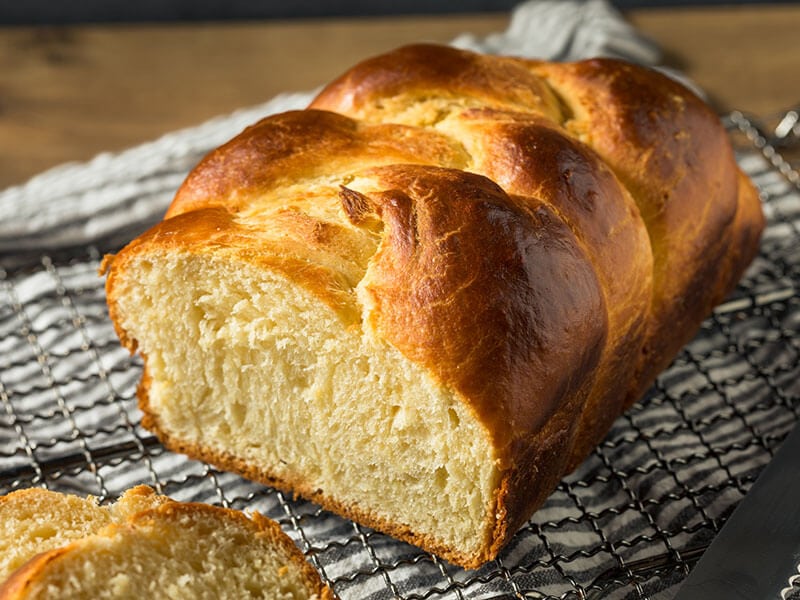
Who cannot love a light, fluffy, and golden bread-like Brioche, right? These bread loaves are the highlight of French foods. With a high amount of egg and butter, they are so soft, rich, and a bit flaky that it makes everyone want to devour them immediately.
The first appearance of Brioche was in a French-English dictionary in 1611, described as spiced bread. Its etymology is unclear, but many people believe it derives from the term “brier”, which indicates a wooden roller to aid the kneading process.
Brioche has various shapes and styles for both sweet and savory versions. Brioche that you usually see in the supermarket is the basic form made with flour, egg, butter, yeast, and liquid. But some of them come with fillings.
17. Bagels
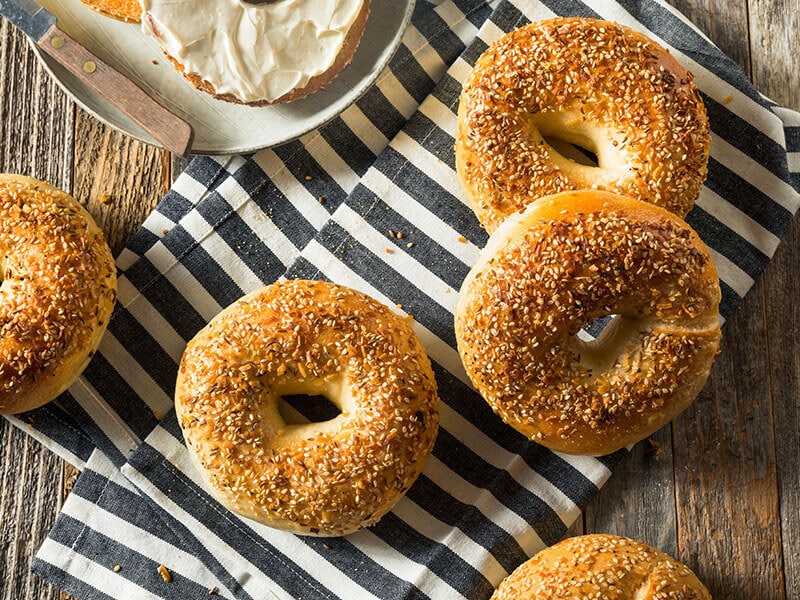
Bagel – small round bread with a hole in a center that resembles a ring, is native to Jewish people in Poland. After Polish Jews brought it to the USA, this bread started to develop its recognition in New York City. Back then, all bagels were prepared by hand.
Traditionally, bagels are made from wheat flour, water, salt, and yeast. After shaping the yeasted dough into a bagel shape, they need to undergo the proofing stage in a minimum of 12 hours at low degrees; then, people boil them in water before baking.
This process gives bagels a unique flavor with a chewy and glossy texture. Thus, you need a precise method to preserve your bagels’ qualities.
When you tear them apart, you can feel a bit of crispiness on their golden-brown crust. However, the texture of them might be different from variety to variety or from region to region.
Some varieties of bagels might come with fillings; some have toppings like sesame, poppy seeds, or cheese. But generally, they are convenient bread that you can buy fresh or frozen in many supermarkets and bakery stores.
What secrets make New York bagels that delicious? This is the answer that you are looking for.
Several Tasty Bread Made With Sourdough Culture
Sourdough is the natural leavened method from the reaction between yeast and wild Lactobacillaceae, creating the lactic acid with sour flavor in the bread. It doesn’t need commercial yeast to rise.
18. Sourdough Bread
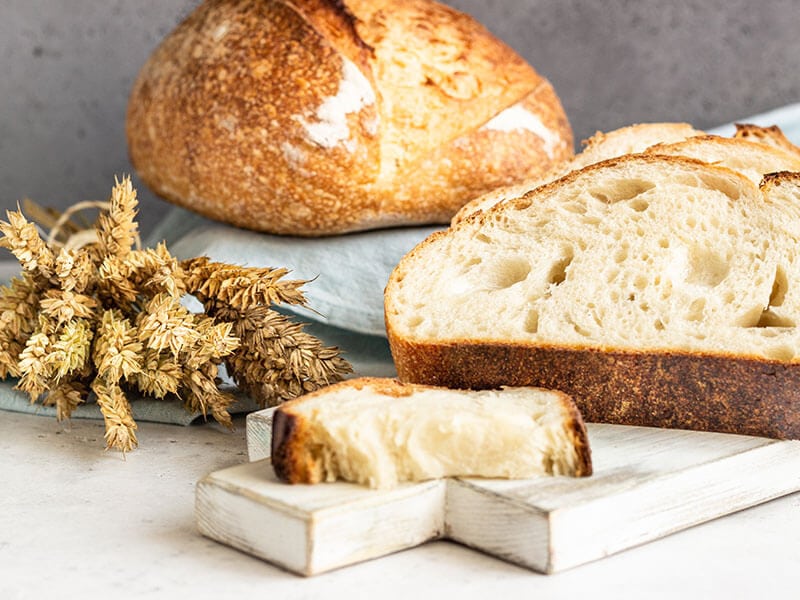
The most basic and easiest-to-recognized variety is sourdough bread. To make it, people use a sourdough starter to be a natural leavening agent and create the form of the dough.
These bread loaves use fermented flour and water to make the dough rise, creating a mildly sour taste, a slightly chewy texture inside, and a thick crust outside. You can effortlessly make them at home with a Dutch oven pan, and there is no kneading requirement.
Regarding sourdough bread origin, it can be seen as the oldest form of leavened bread from ancient Egypt, when some people accidentally left the bread dough out for too long. But wild yeast saved the dough and transformed them into tasty bread like today’s version.
This guidance will show you how to make perfect sourdough bread at home.
19. Coppia Ferrarese
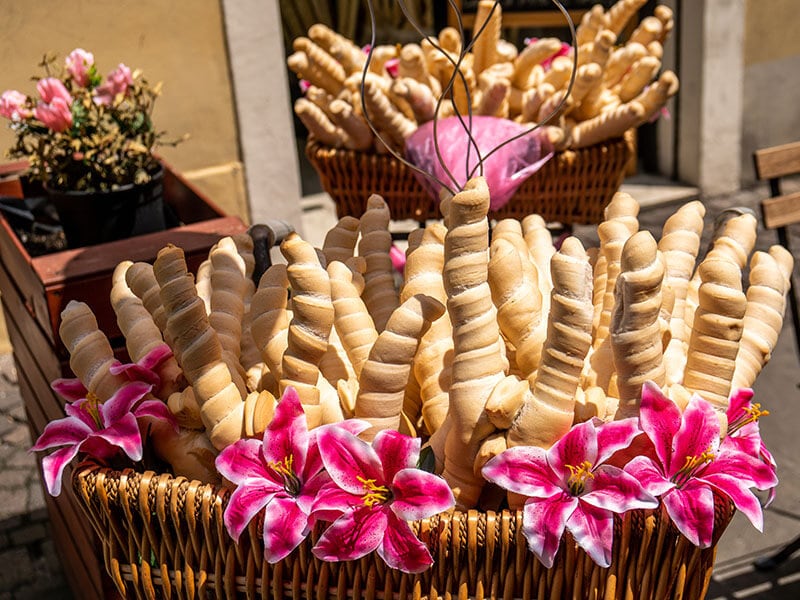
Coppia Ferrarese is a sourdough bread formed as a double twisted loaf. They are symbolic of Ferrara city in Italy. The first Coppia Ferrarese appeared in this city around the 13th century.
Besides the special twisted shape, this bread is very eye-catching because of its golden color. With flour, malt, olive oil, and lard, bakers mix them to prepare the dough and stretch the dough into a long cylinder. After that, they cut it into shorter strips to tie and form a double twisted loaf.
The flavor of Coppia Ferrarese is also distinctive and tasty. They are also crumbly, crunchy, and soft inside to be an awesome accompaniment to other food, like ham slices.
20. Borodinsky
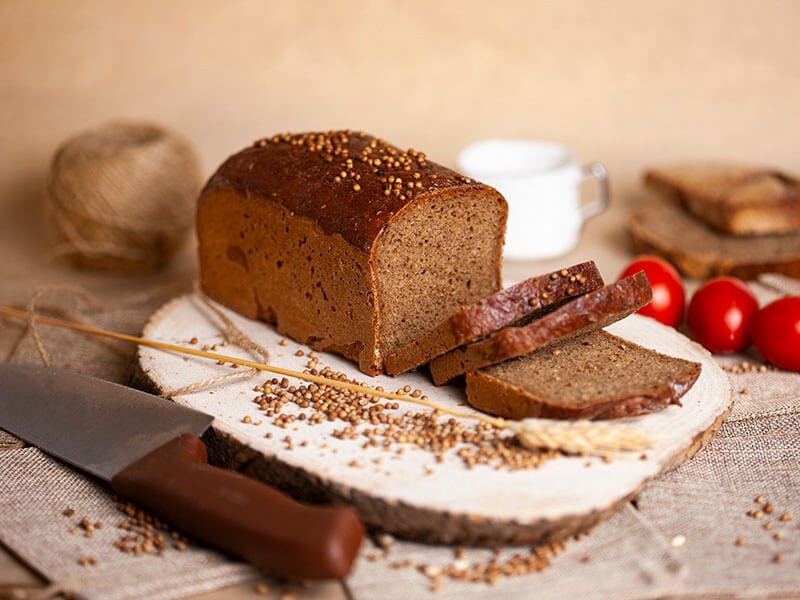
Borodinsky is a superb Russian food that resembles rye bread, with a similar dark brown color and dense texture. However, the ingredients for making a Borodinsky are more complicated.
First, they include a mixture of rye flour and wheat flour. Traditionally, it must contain a minimum of 80% whole-grain rye flour, 15% wheat flour, and 5% rye, plus a sourdough culture to leaven. They are also sweetened with molasses and flavored with caraway or coriander seeds.
In short, Borodinsky bread should be moist inside and flavorful with both sweet and sour tastes. But the sweetness might be a bit stronger than the sourness.
Here is an ultimate guide to preparing an authentic Russian Borodinsky loaf.
21. Parāoa Rēwena
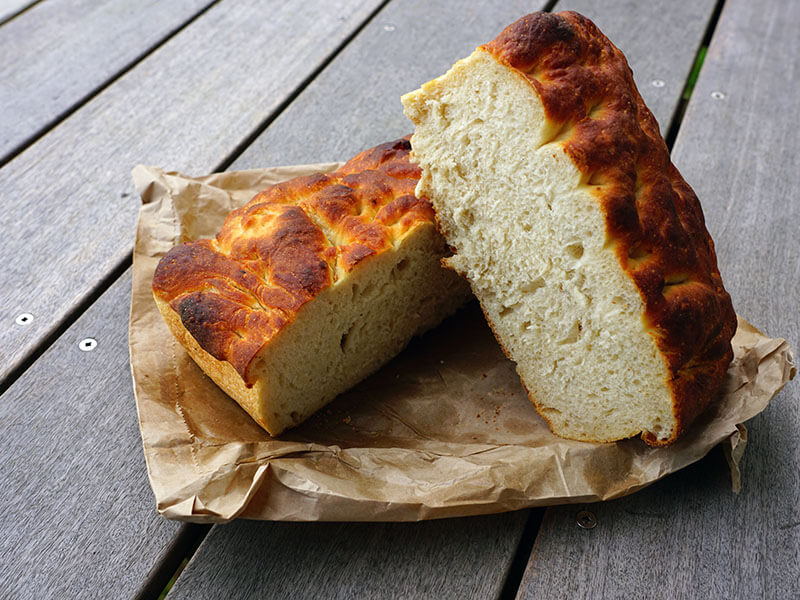
The next bread type used sourdough starter is Parāoa Rēwena bread from New Zealand. Specifically, Rēwena bread uses a fermented potato starter (called “bug” in this country) to create a firmer texture.
Parāoa Rēwena means “flour leaven” and comes from Māori people – indigenous Polynesian in New Zealand. Making this bread is not too simple as there are several cooking stages.
First, you need to boil and mash potatoes, then add flour and sugar. It will take a few days for the mixture to ferment to create the potato starter. Thanks to this starter, it creates a sweet and sour taste in Rēwena bread.
22. Maltese Bread
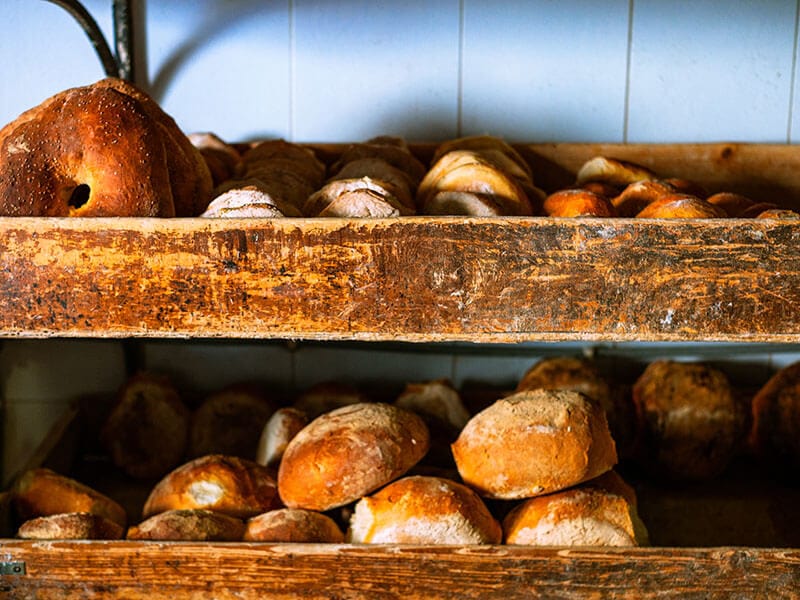
Maltese bread is a delicacy from Malta – an island country in Europe. A crusty exterior, a springy soft interior, and a slight sourness are some of its distinctive characteristics.
They have been a staple food in Malta for a long time. Normally, the locals love to consume it with olive oil, crushed tomatoes, and top it with tuna.
Maltese bread is usually baked in wooden ovens and available in a round loaf shape. But making a perfect Maltese bread is time-consuming and requires many kneading actions.
23. Rugbrod
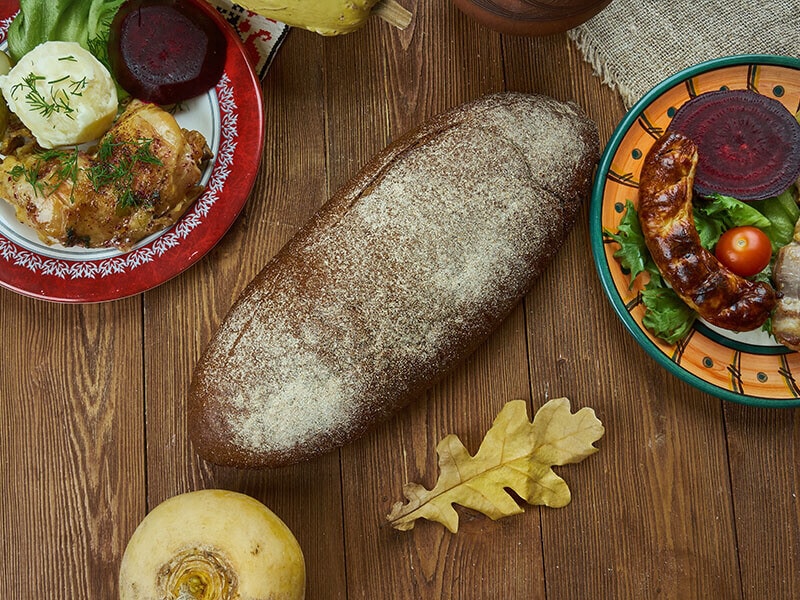
Here is Rugbrod bread, a Danish food specialty with an iconic dark brown and long rectangle appearance. Why do they have a dark color? Because this is a popular bread made with rye flour, like regular rye bread that I have introduced above.
Therefore, Rugbrod might contain 100% rye flour, though whole rye grains can sometimes account for 30% of the bread. Other additions, like wheat flour or sweetening agents (sugar and molasses), can change overall taste.
Sadly, Rugbrod might not be an ideal homemade bread since they need a very long time for leavening. But the good thing about Rugbrod is its high levels of vitamins and minerals. They are also low in fat, making them perfect for your diet.
Danish Rugbrod is a rich source of nutrients that you should try someday to improve your diet quality.
7 Quick Bread Types That Will Not Need Too Much Time To Prepare
If you do not have too much time to prepare a loaf of bread, you should go with quick bread. It doesn’t take much time to make thanks to the absence of traditional leavening agents like sourdough starter or yeast.
Instead, baking powder or baking soda is used to make it rise. Quick bread can be divided into bread made with dough and bread made with batter. Here are 7 famous types of quick bread that I want to introduce today!
24. American Muffins
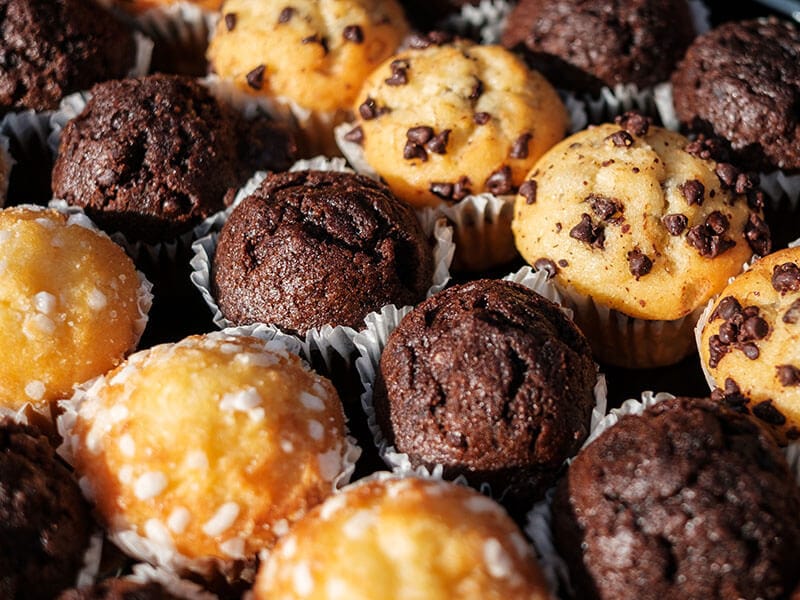
Muffins are bite-sized treats designed for individual serving. They can be either flatbread or quickbread. American muffins are a perfect example of the latter.
American muffins can come in both sweet and savory flavors. With sweet ones, their ingredients might be chocolate chips, fruit flavors, and blueberries, not to mention main components like flour, baking soda, sugar, and eggs. But if you like to enjoy them as savories, go with cheese muffins.
They might look like cupcakes because people have to use a mold for baking them. You can easily buy them in various coffee shops or supermarkets in packages. If you want to try something new, poppy seed muffins or bran muffins totally deserve a shot.
25. Banana Bread
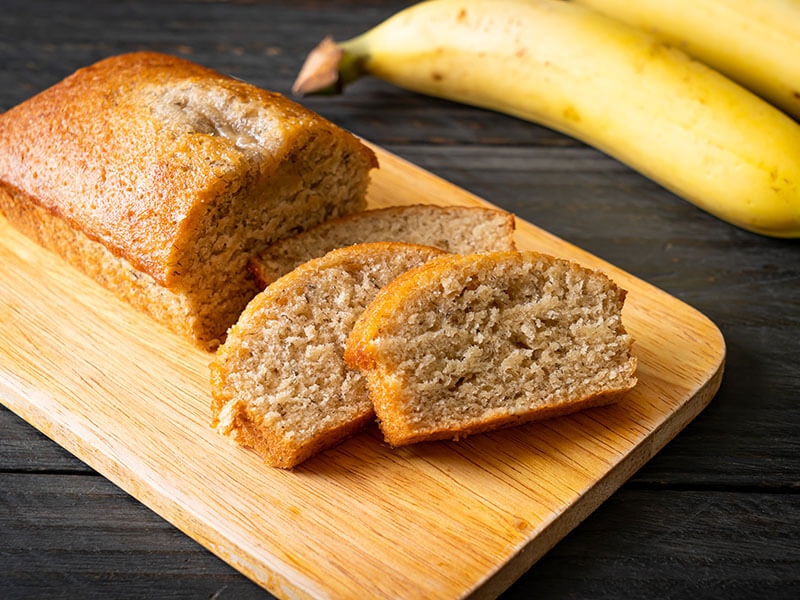
Banana bread is a tasty bread made with mashed ripe bananas. So if you accidentally bought many bananas, let’s turn them into this bread. The first recipe of banana bread appeared in a cookbook from 1933. It has been a favorite store-bought bread across the USA since then.
Made from bananas and common baking ingredients, they can be a hearty American treat for your weekend. You can feel their sweetness, smooth texture with a hint of bananas in every bite of them.
They are also super moist that can make your kids love it right from a first try. And the best part is that you don’t need too much skill and time to prepare some yummy loaves of banana bread.
Banana bread will not ask for too much physical effort, so if possible, let’s surprise others with these tasty loaves.
26. Pumpkin Bread
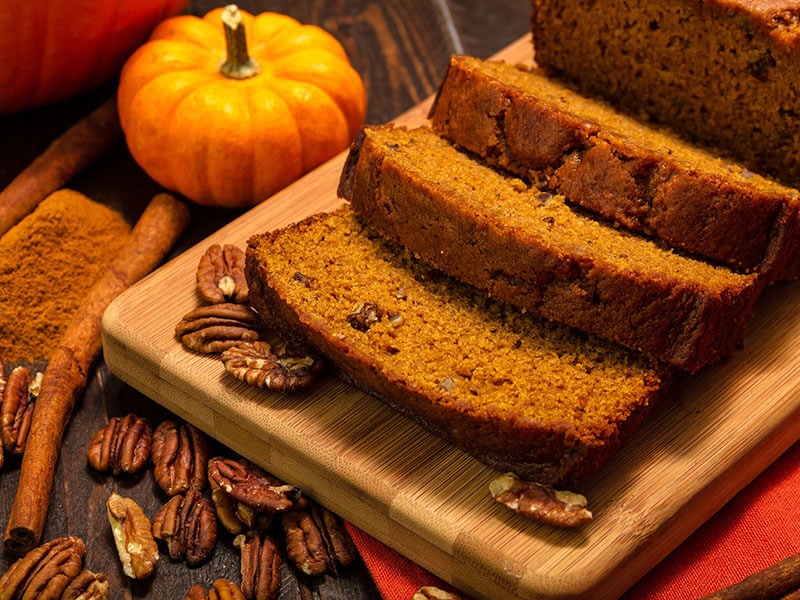
When the fall is coming, it is time to enjoy pumpkins. And it would be more delicious if you could make a couple of loaves of pumpkin bread. What I love about this bread as it can be a simple idea to use canned pumpkin or fresh pumpkin. Either way is acceptable.
It is hard to determine precisely who invented this hearty treat. But today, they are fall-spirited food that not a single American can refuse, thanks to its light sweetness with a nice aroma from spices like cinnamon or nutmeg.
A nice pumpkin bread should be super moist, soft, and not too dense in texture, creating the coziest treat to celebrate the fall.
27. Scone
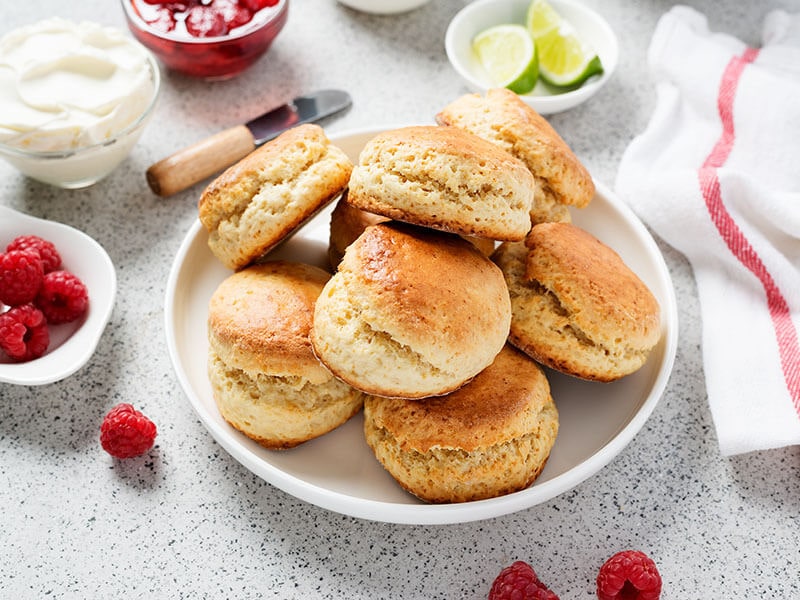
It is hard to deny a scone when enjoying a cup of cream tea. Indeed, scones are simple quick bread with a light sweetness that you can serve with jam and whipped cream to make your afternoon tea more pleasant.
Besides sweet scones, you can find some savory versions with cheese, bacon, onion, currants, etc. There are other varieties of scones, like griddle scones in Scotland, where they use a griddle for cooking them instead of an oven.
In the USA, scones can come in triangular shapes. They are quite dry, heavy, and crumbly with sweet flavors from fruits or chocolate chips.
28. Barmbrack
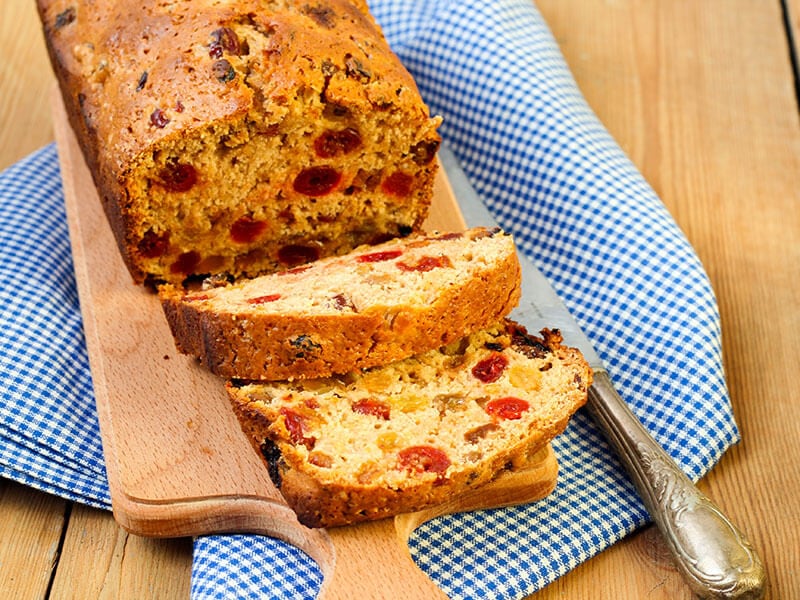
Barmbrack is an ideal option for grape lovers since it has both dried and fresh grapes, which are raisins and sultanas – a famous one invarious kinds of grapefor making wine. They are also a symbol of Irish Halloween.
In Ireland, they usually use Barmbrack for a game in which locals put a ring (symbolic of good luck) inside the bread, so whoever gets this ring will be more fortunate in the future. This bread is also associated with New Year’s Eve in this country.
Another name of Barmbrack is bairín breac, where “bairín” means loaf, and “breac” is for “speckled” to imply the small dot of raisins inside a bread. The best way to enjoy them is with a cup of tea or toast and serve them with butter.
This guidance will tell you the secret behind a yummy Barmbrack of Irish.
29. Biscuit
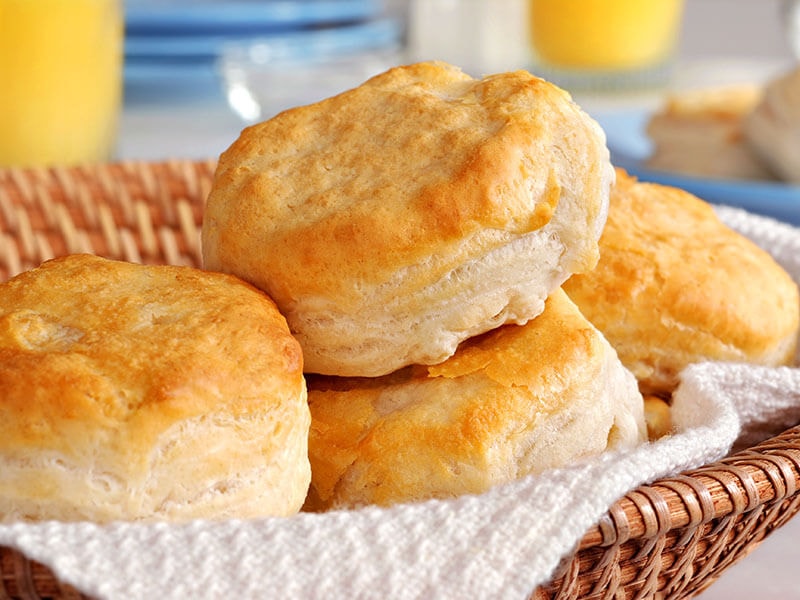
Do not mistake this biscuit with other flour-based hard biscuits. These small pieces of bread are American and Canadian biscuits – a variety of quick bread. They are soft and quite crumbly inside with a firm exterior.
They use baking powder as the chemical leavening agent. There is no need to wait for the dough to rise. There are various ways to prepare them.
Baker can roll the dough flat and then cut them into round pieces to expand when baking. Alternatively, they can add liquid to create drop biscuits with countless shapes and textures.
In the USA, these biscuits can be served anytime you like. They can be your breakfast with a bit of honey, syrup, jam, or butter. Feel free to make dinner with them by serving with fried chicken.
30. Soda Bread
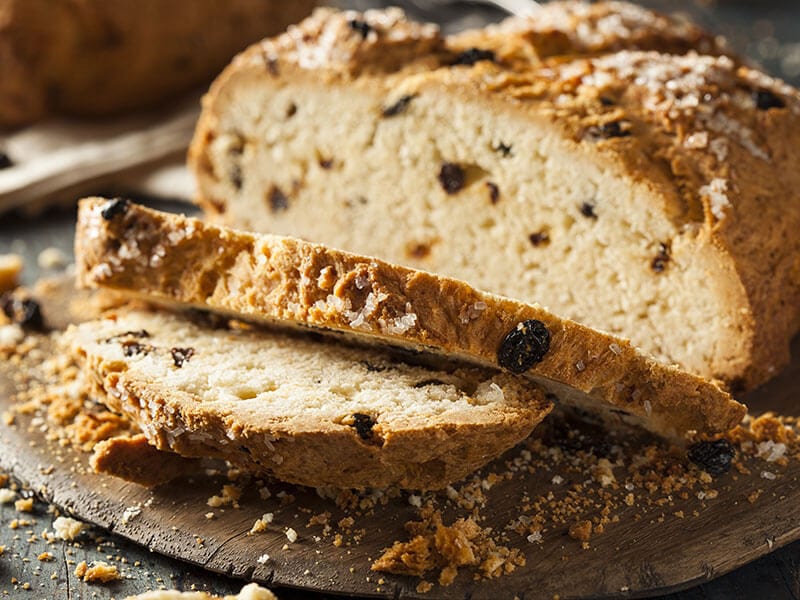
Soda bread is a wonderful recipe of Ireland in bread making. Instead of using yeast, baking soda is a leavening agent of this bread. When this agent mixes with buttermilk dough, it can create many tiny bubbles, so do not be alarmed about this reaction.
Another important component of soda bread is coarse flour, which can be wholemeal or white. To make the bread more delicious, people can also add other ingredients like raisins, eggs, or butter. Conveniently, you do not need to knead the dough while making it.
Soda bread has a dense and tight texture with a very mild flavor. That’s why people typically enjoy it with other foods, like jam, butter, or meat.
Do not skip this instruction; otherwise, you will not know the best trick to make a stunning loaf of Irish soda bread.
Can You Say No To These 7 Types Of Bread?
The last part is about types of bread from other categories. They vary from each other in terms of origins, ingredients, usage, etc. So keep reading so as not to miss any insight about them.
31. Ciabatta
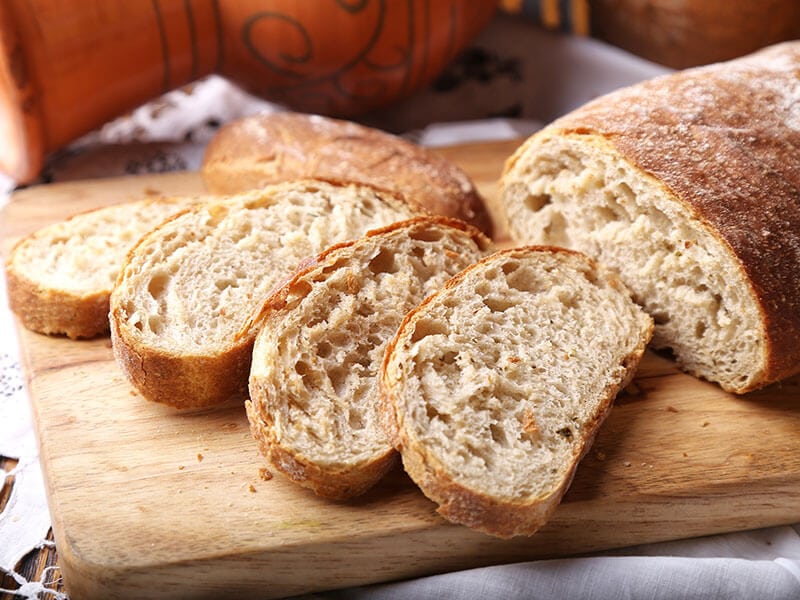
The world of Italian bread is full of surprises, and Ciabatta is another wonderful delicacy in this country. They are simply Italian-style white bread that contains wheat flour (or whole wheat flour), salt, water, and olive oil.
Ciabatta was a product of a baker named Arnaldo Cavallari as he tried to find a sandwich recipe to replace the French baguette in Italy. Eventually, he introduced Ciabatta bread in 1982, a product that uses high gluten flour to make a soft and wetter dough.
The unique characteristic of this type of bread is their big alveolar holes inside since the bread is made from the wetter dough. However, it is still perfect for sandwiches, such as panini – a kind of sandwich that includes small Ciabatta.
There are several similar recipes of Ciabatta in different Italian regions, but most of them have a long rectangle or roll shape with a chewy crust and moist interior. However, the Tuscany Ciabatta tends to be crisper in the crust and more open in texture.
Does homemade Ciabatta taste better than store-bought ones? So check this guide to learn more about it.
32. Breadstick
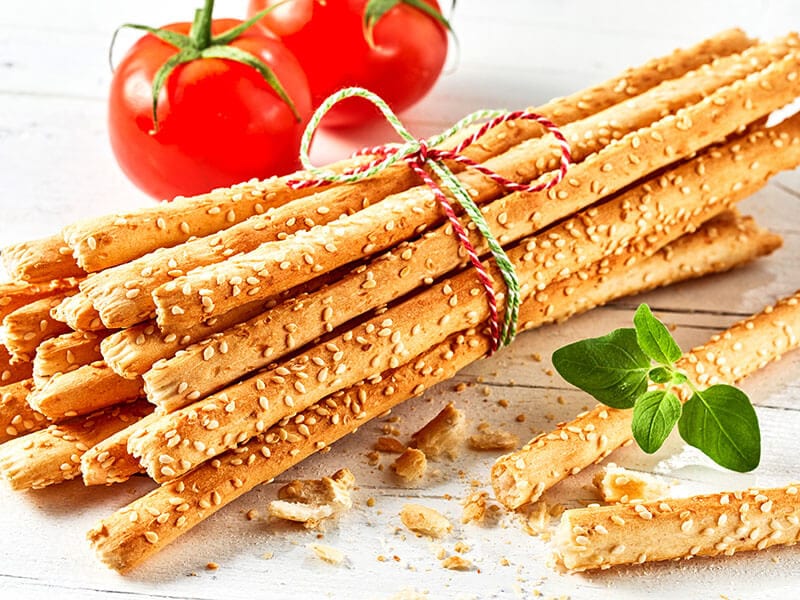
Breadstick is a type of dry-baked bread that comes in stick shapes. Its other names are dipping sticks, grissini, or grissino. This is another culinary delight from Italy.
Today’s breadstick perhaps owes its origin to a long-shaped bread created in 1643 in the town of Lanzo Torinese, Turin. It could be an invention of a baker named Antonio Brunero.
Traditional breadsticks have a crispy texture, but some versions in other regions of Italy might be soft. They are usually served as an Italian-based appetizer. But in North America, they can be a dessert component to top with sugar, icing, or cinnamon.
33. White Bread
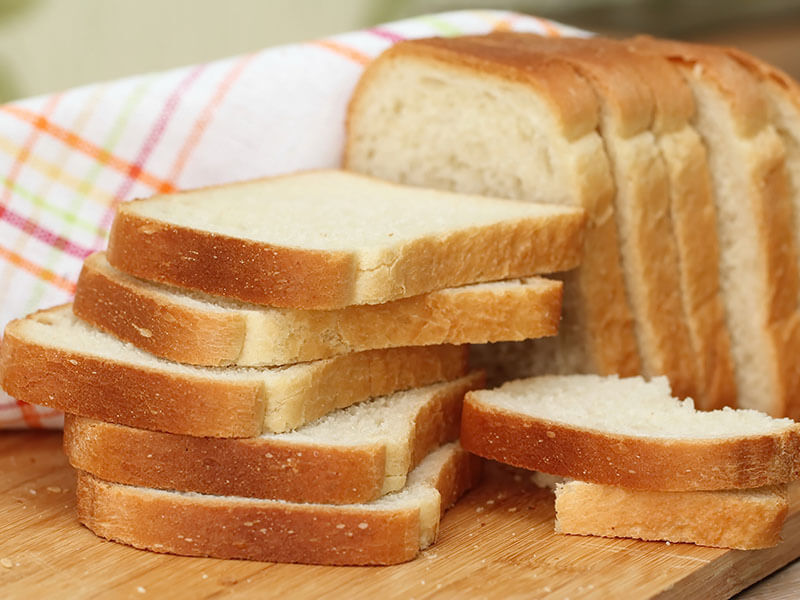
White bread can be found in any place in the world. They are a classic type of bread made with wheat flour and easy to make at home if you have a baking oven.
Indeed, white bread is soft and delicious. Sometimes, people use the term ”sandwich bread” or ”sandwich load” interchangeably to refer to this type of bread. Compared to other varieties, this one is quite bland and has fewer healthy nutrients.
But what makes them so popular among consumers is their easy accessibility. They are very easy to chew and digest. Their excellent shelf life is another plus point.
You might not want to spend any penny for ready-made white bread after watching this instruction.
34. Belgian Waffle
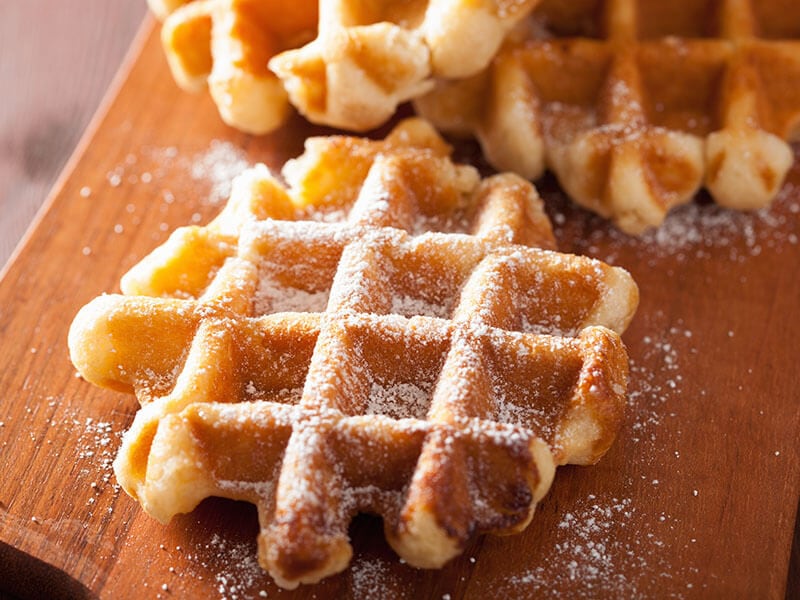
Let me show you another unique kind of bread that might look totally different from all the bread discussed here. This is Belgian waffles, an outstanding food from Belgium that people of all ages love.
People used to make them with yeast, but most modern versions include baking powder. If you need a quick breakfast to energize your new day, the Belgian waffles can be the ultimate solution.
In 1958, these fluffy and crunchy treats were introduced to America through a showcase. Nowadays, it is regarded as a favorite dish among Americans. People usually enjoy them along with whipping cream, fruits, syrup, or chocolate spread.
35. Pumpernickel
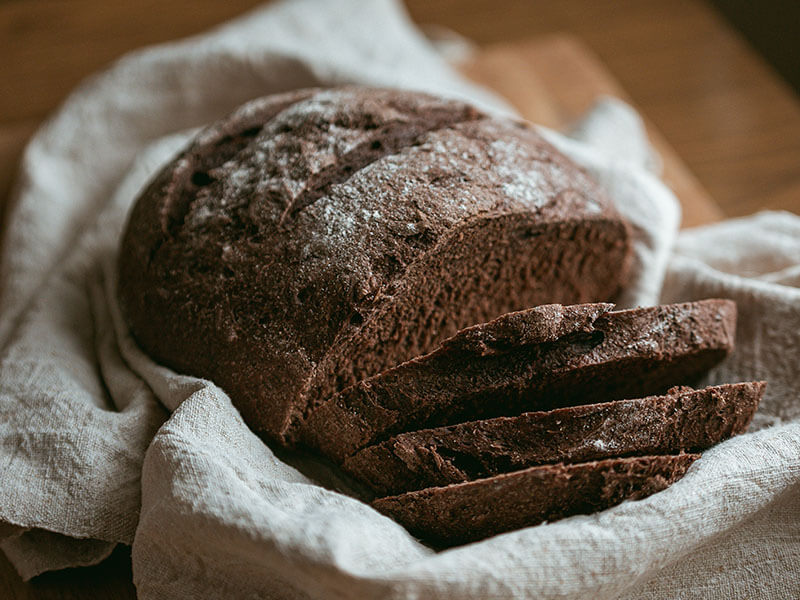
Pumpernickel is a dense, coarse, and quite heavy bread with a particular dark brown color. They belong to the rye bread type because Pumpernickel consists of finely ground rye and acidic sourdough starter. They might be made from a mixture of rye flour or whole rye grains as well.
The history of Pumpernickel is blurry, but everybody knows that it is a perfect bread to pair with caviar or smoked salmon. Also, locals use it as an ingredient to make a German-based dessert named blushing maid.
This type of bread undergoes a long baking duration (from 16 to 24 hours in a narrowed pan with a lid), resulting in its dark color.
Another distinguishing trait of Pumpernickel is they have no (or little) crust, plus a slightly sour and sweet flavor. In Germany, people commonly sell them in a small package that you can easily get from the supermarkets.
36. Multigrain Bread
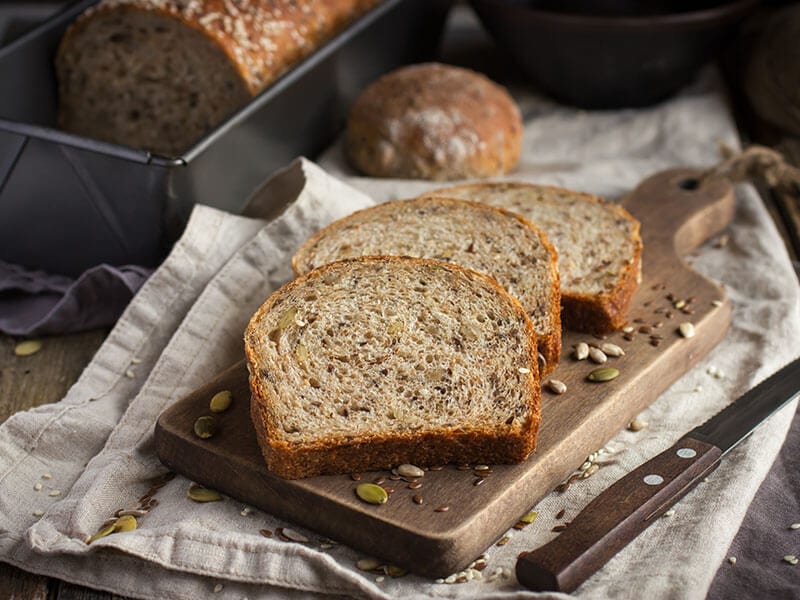
As the name suggests, besides some basic ingredients to make bread, multigrain bread has to contain at least 2 types of grains to create a healthy bread loaf. And they can be millet, wheat, oats, or barley. Edible seeds of sunflowers, pumpkins, or quinoa also count.
Since they are made with various grains, this bread’s health benefits are more significant than regular white bread. If you seek a complex carbohydrate or multiple-vitamin kind of bread, none can beat multigrain bread.
You can use sourdough, rye, or unprocessed grains to make this bread at home. If you buy it at supermarkets, please remember that some commercial brands use 100% whole grain flour to make them.
If you have a Dutch oven pan, an oven, and a lot of grains, it is time to make some loaves of multigrain bread.
37. Pan Dulce
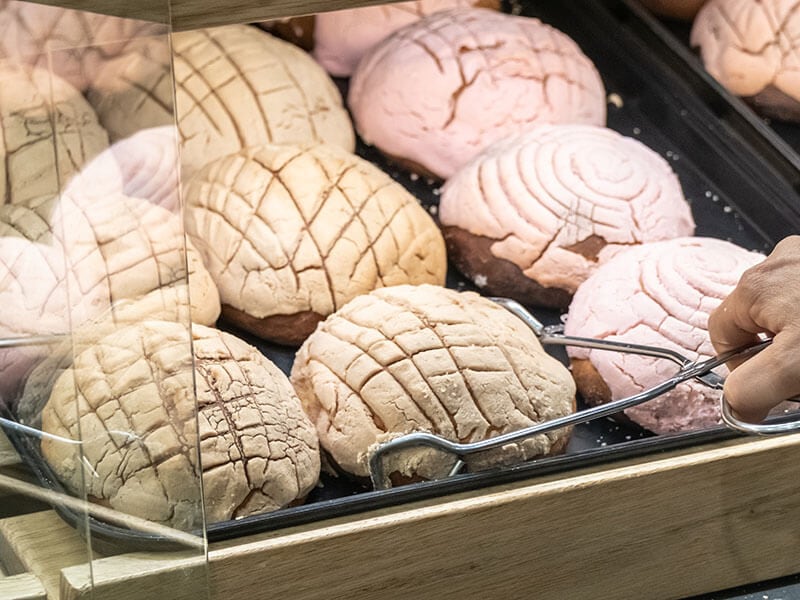
The last bread type is Pan Dulce – a fantastic treat that can be an ideal Mexican-style breakfast (or late supper). For your information, pan dulce means “sweet bread” in Spanish. But are they as sweet as their name?
In reality, Pan Dulce is a generic term to refer to many sweet Mexican breads. Among them, the most recognizable type in the USA must be Concha – a shell-like bread roll with a perfect crunchy topping.
Some Pan Dulce varieties are festive pastries. For example, Rosca de Reyes bread can be a meaningful gift on Three King Day to celebrate Jesus Christ’s revelation, or Pan de Muerto – a special bread for the Day of the Dead holiday in Mexico.
How Many Of These Bread That You Have Tried?
It is not easy to learn all about bread types in one day, but I hope this post can show some of the most famous ones in different countries so that you can know what you should try on your next trip to these places.
And if you find this post helpful, please share it with others so they can learn new things about these delicacies. Don’t hesitate to leave a comment telling me what you think. Thank you and see you in the next article!
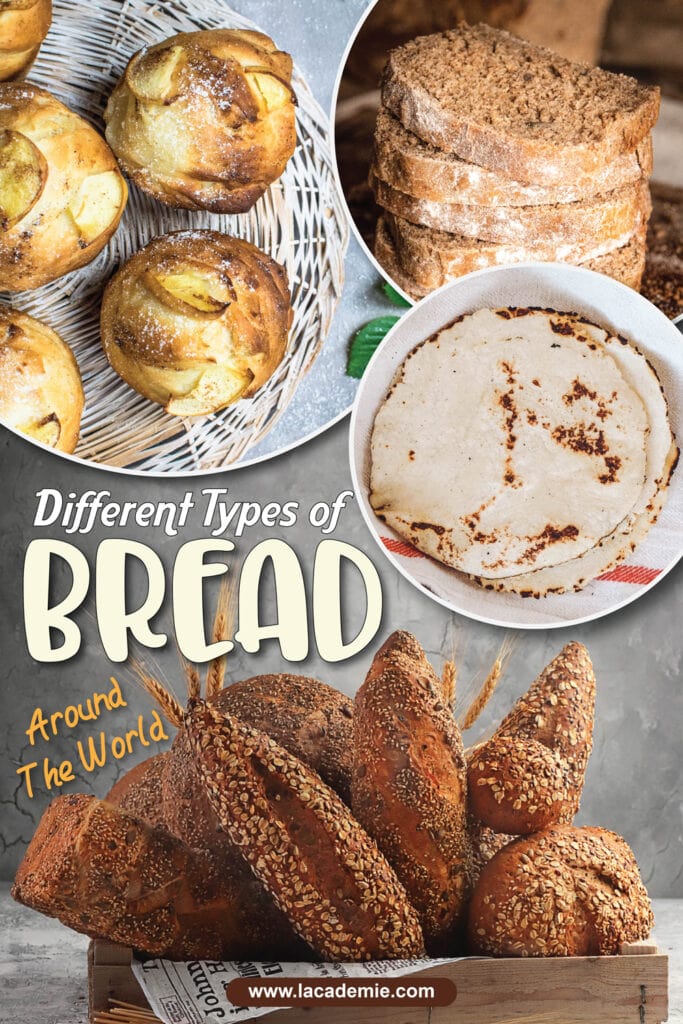


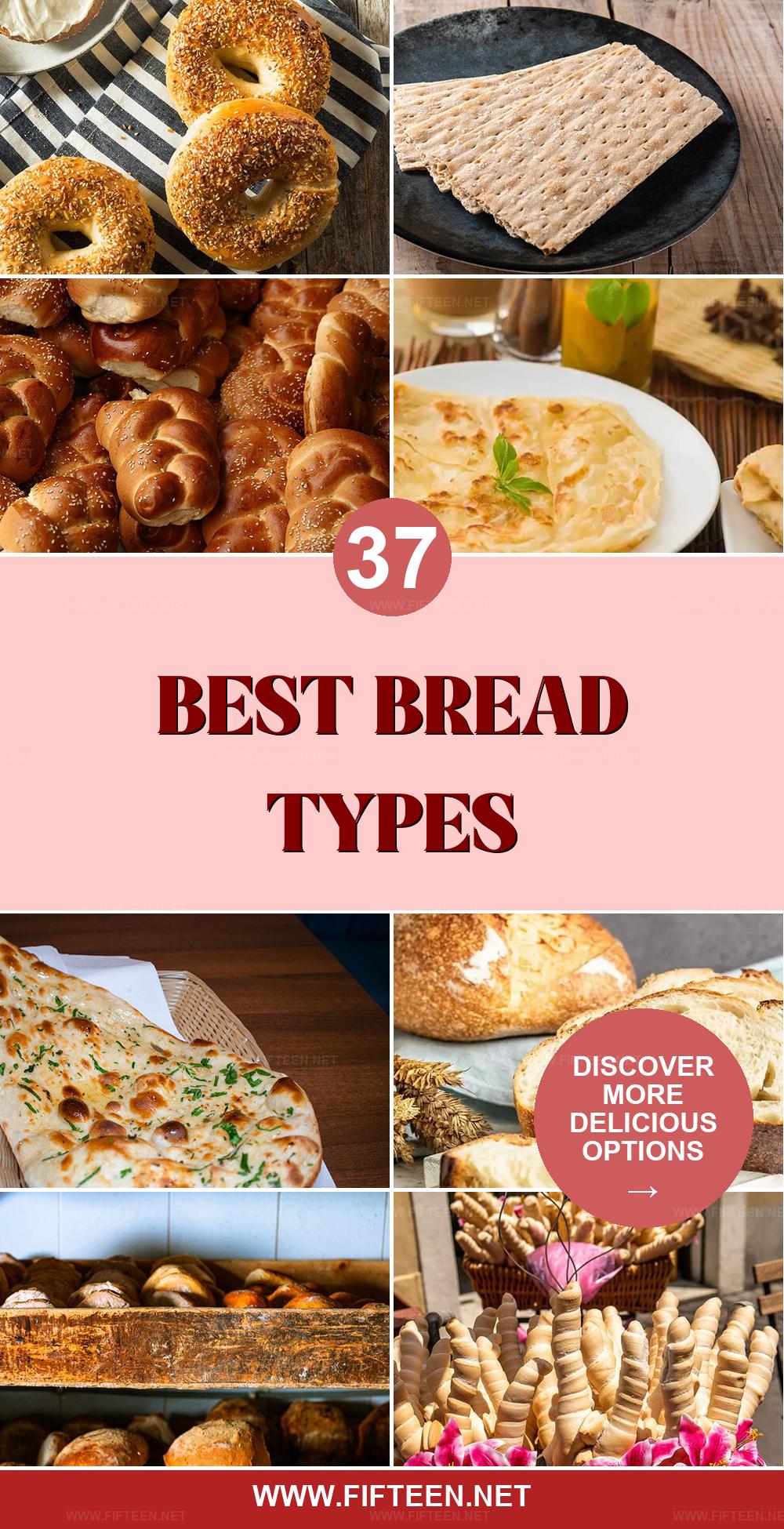
Jamie Scott
Editor in Chief, Senior Content Writer
Expertise
Home Cooking, Meal Planning, Recipe Development, Baking and Pastry, Food Editor, Cooking-video Maker, Western Food Evaluation Expert
Education
Le Cordon Bleu College of Culinary Arts
Local Community College, New York, NY
Jamie Scott is a skilled culinary expert and content creator specializing in Western cuisine. With over 15 years in the culinary field and formal training from Le Cordon Bleu, Paris, Jamie deeply understands how to blend nutrition with delicious flavors. His passion for cooking matches his commitment to making healthy eating accessible and enjoyable.
On Fifteen.net, Jamie brings a fresh perspective to classic dishes and beverages, offering readers insightful recipes, cooking tips, and a fresh view on meal planning that emphasizes taste, health, and simplicity.